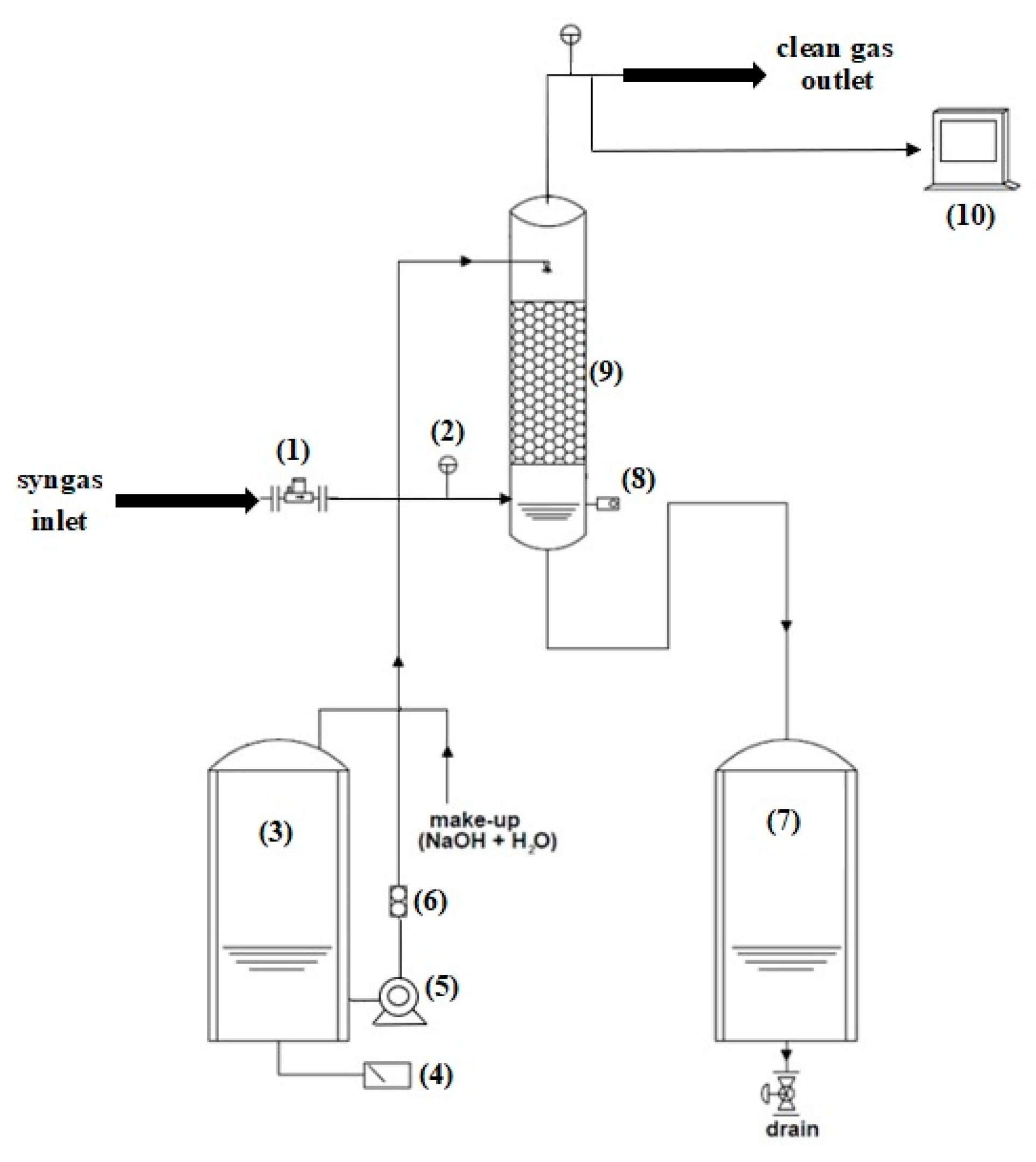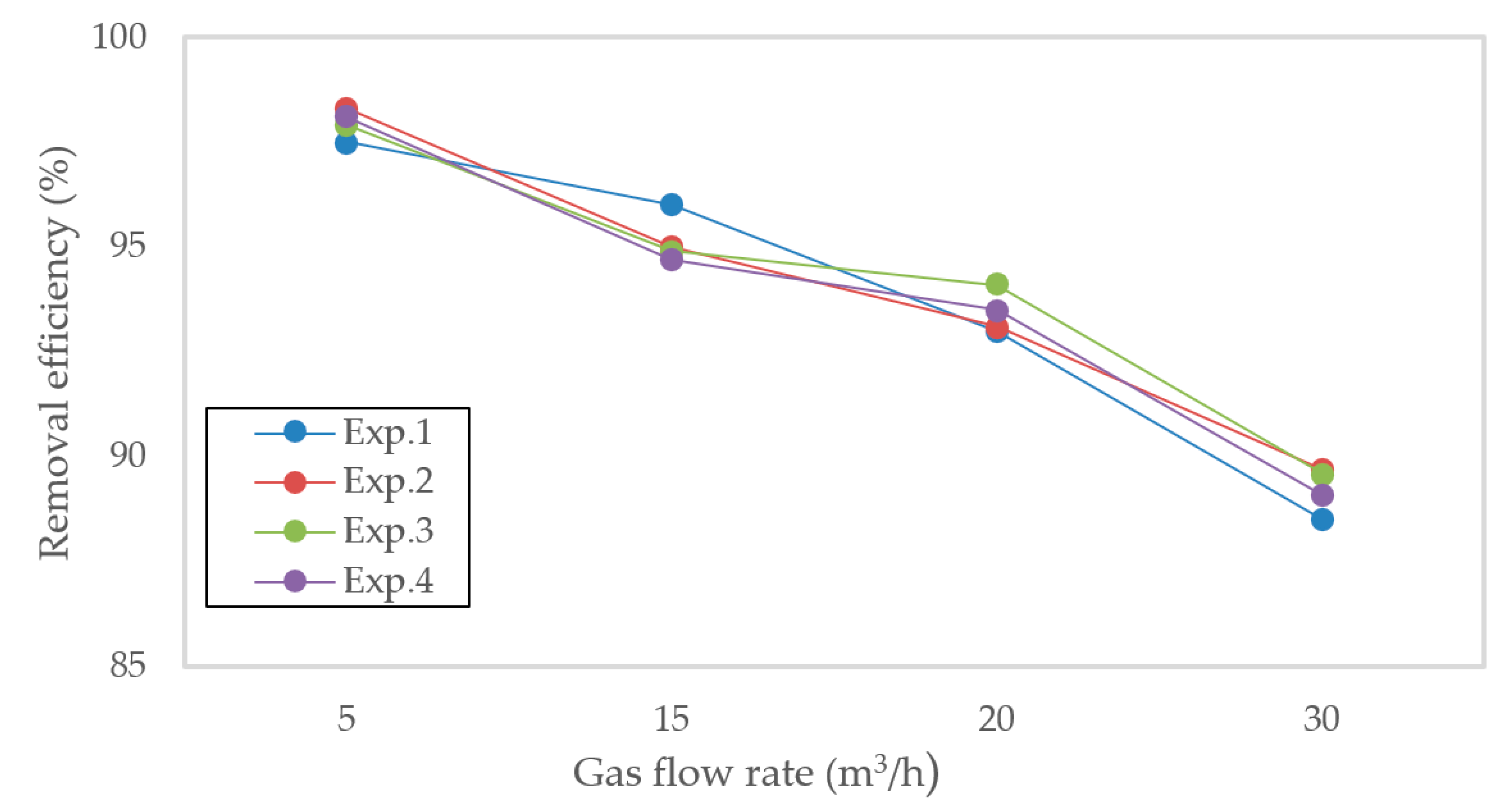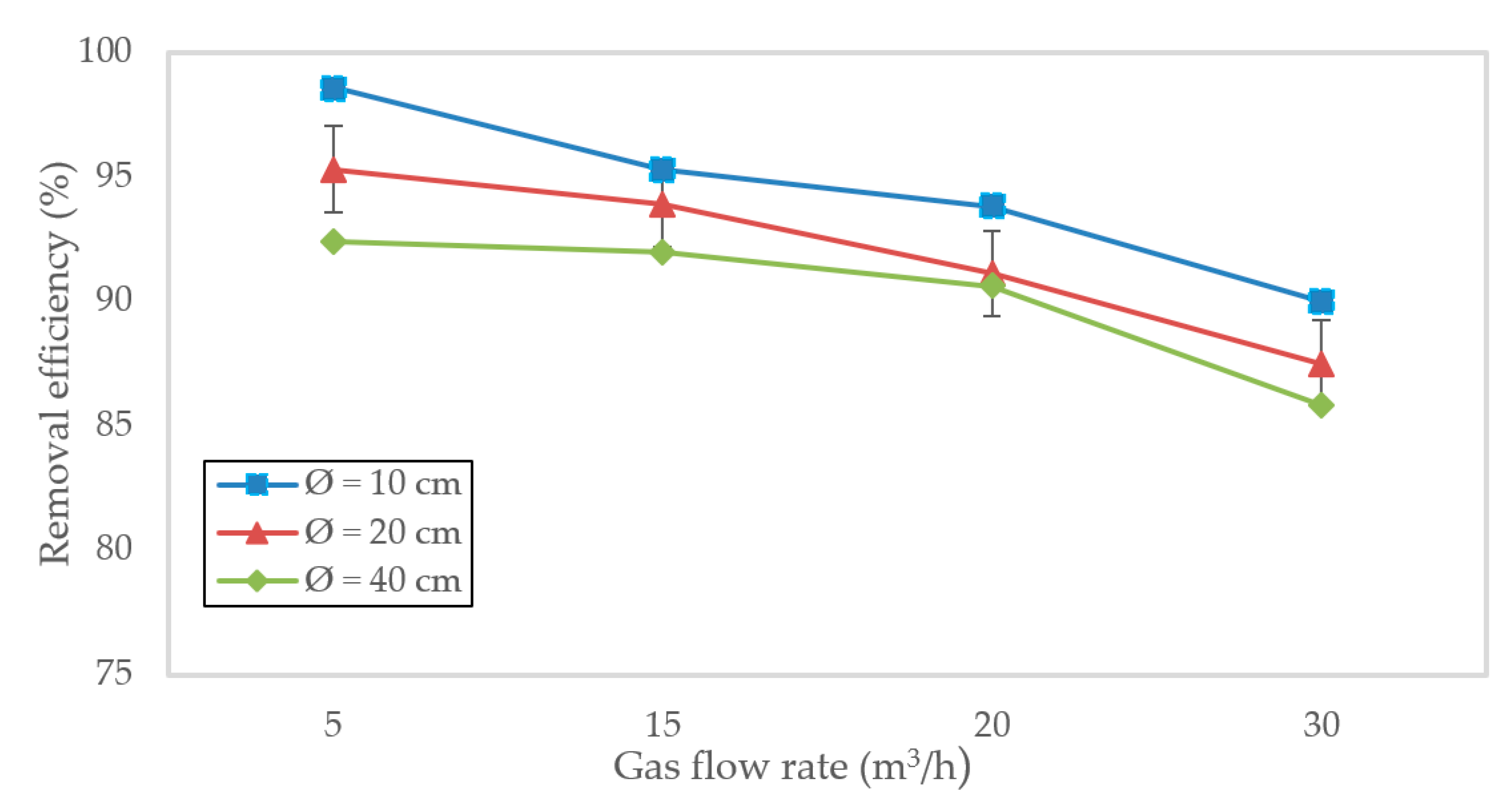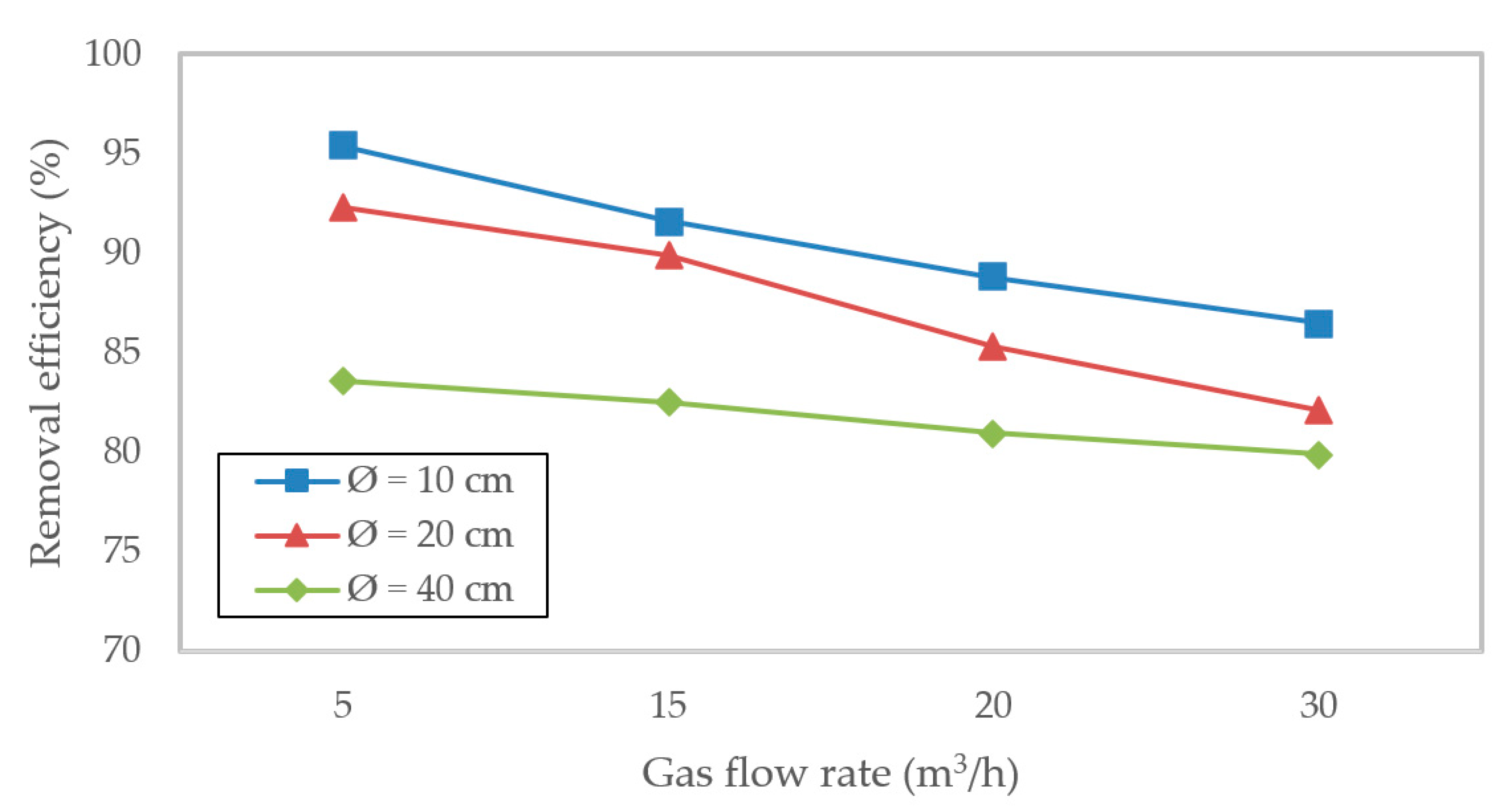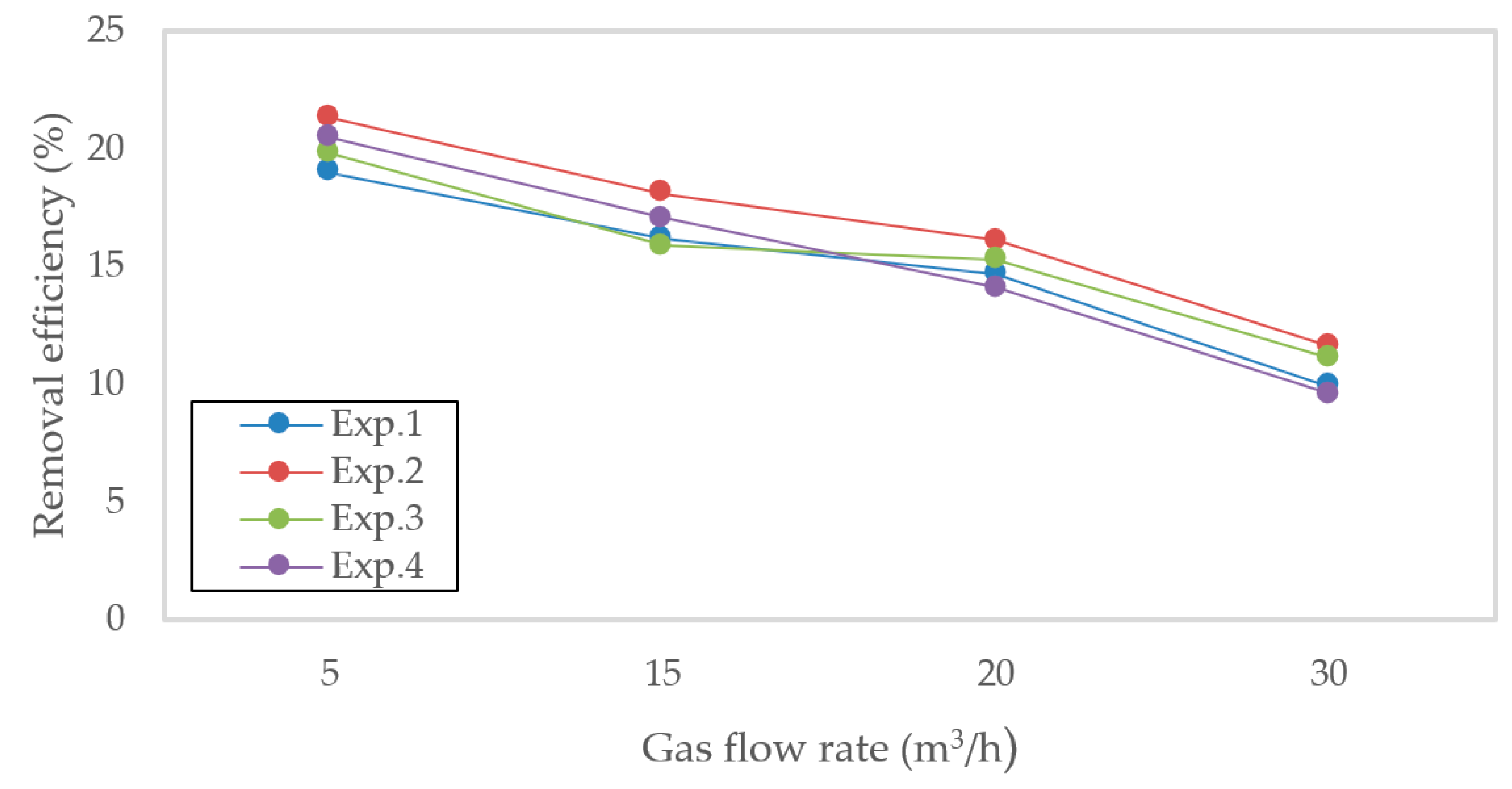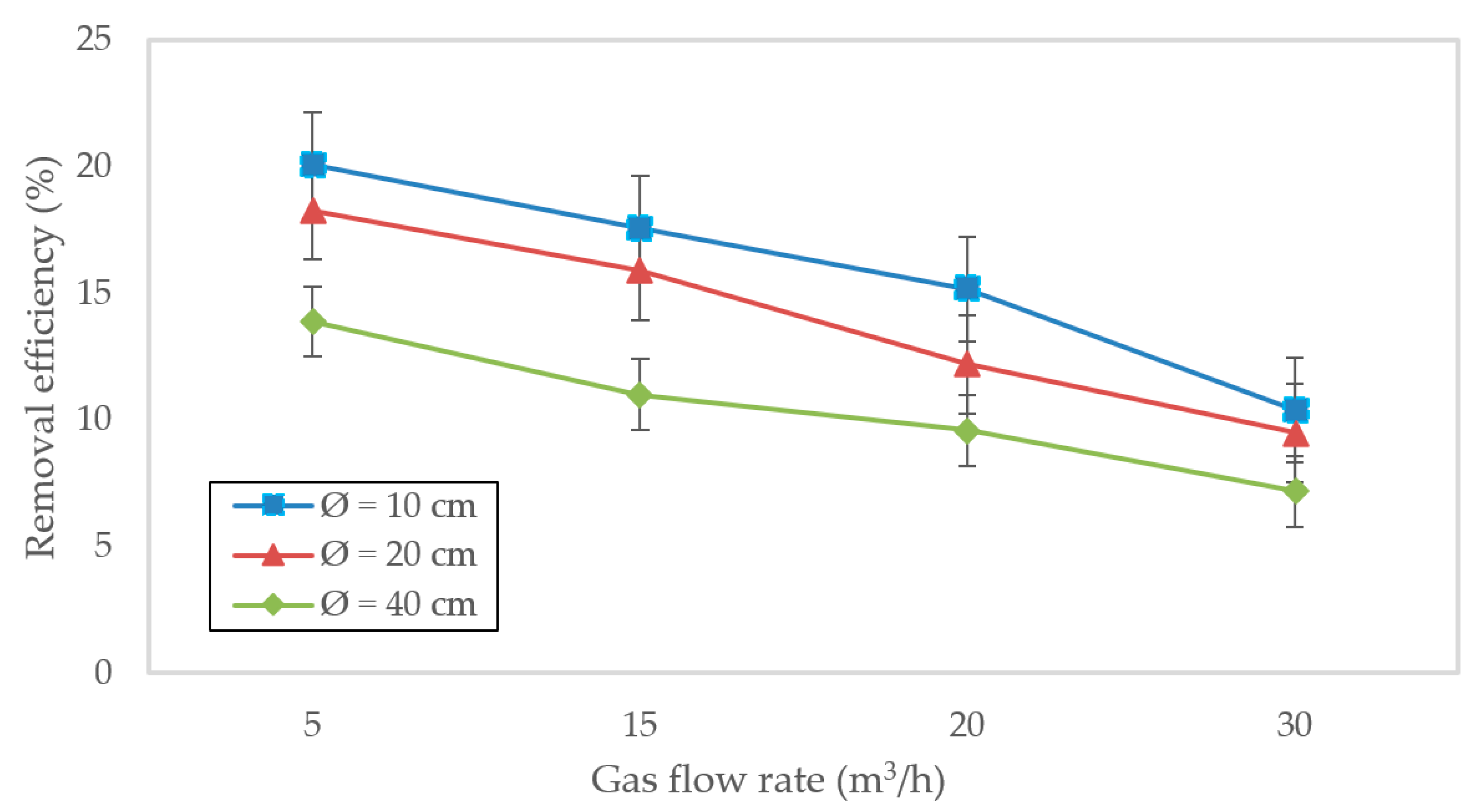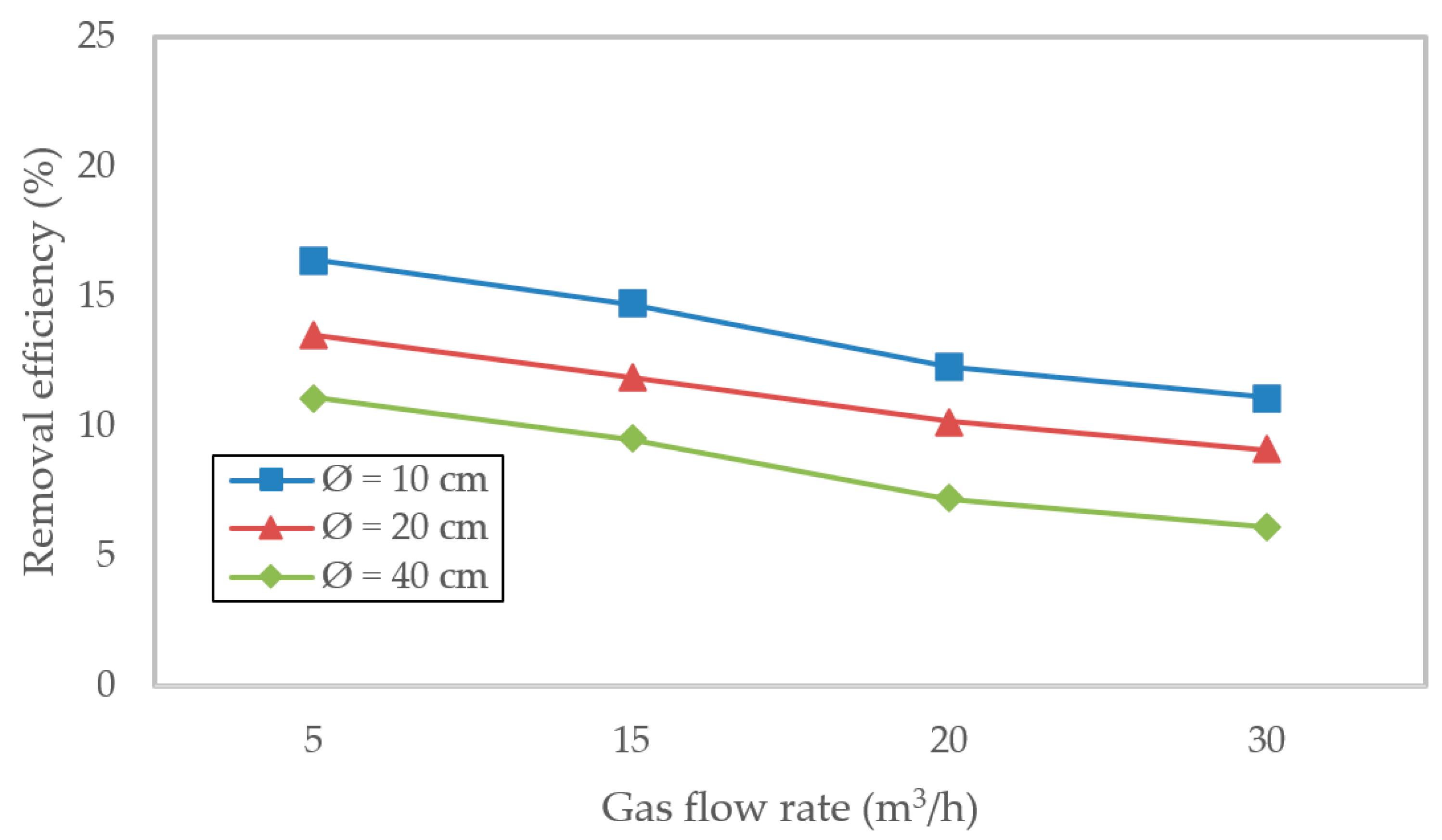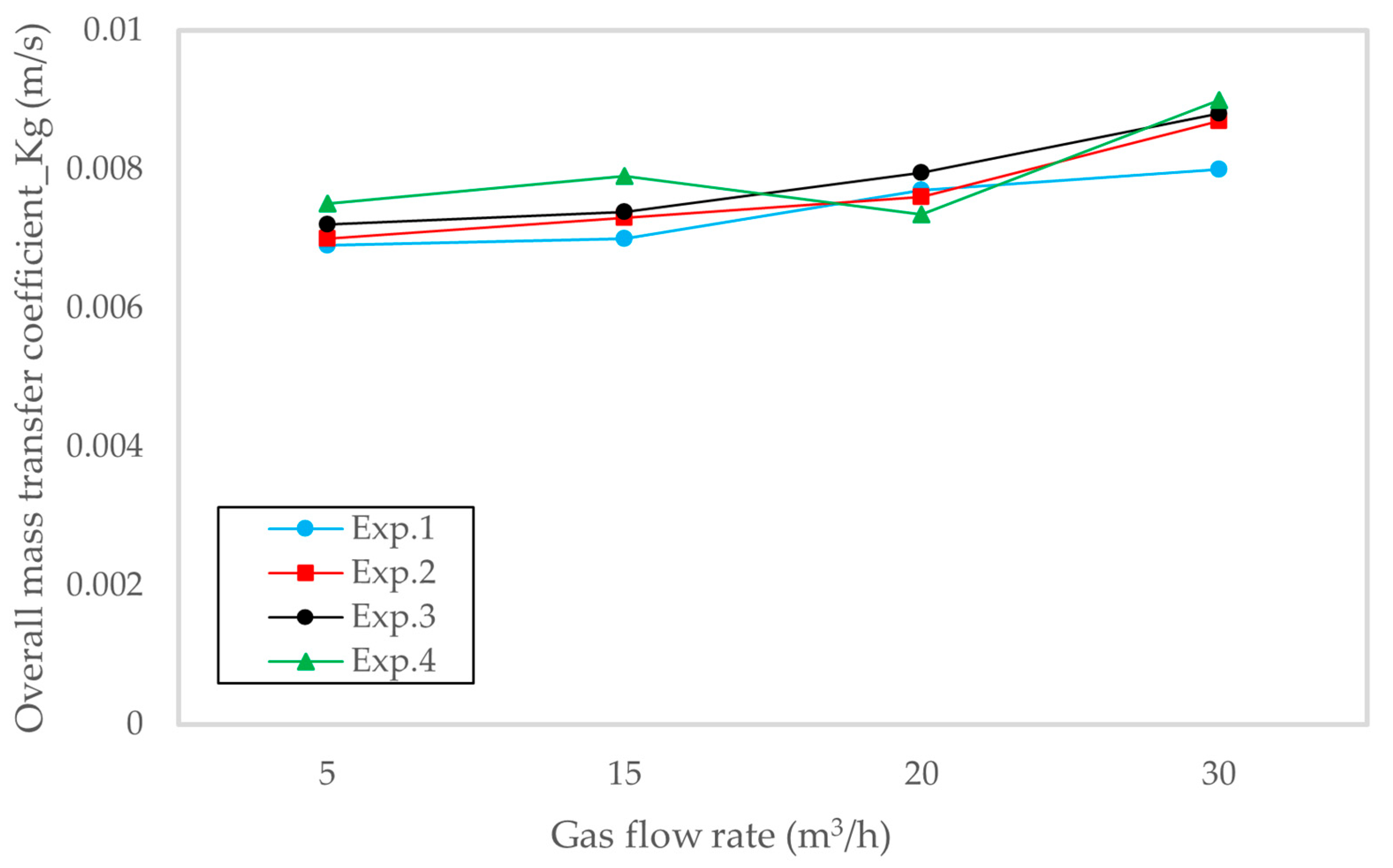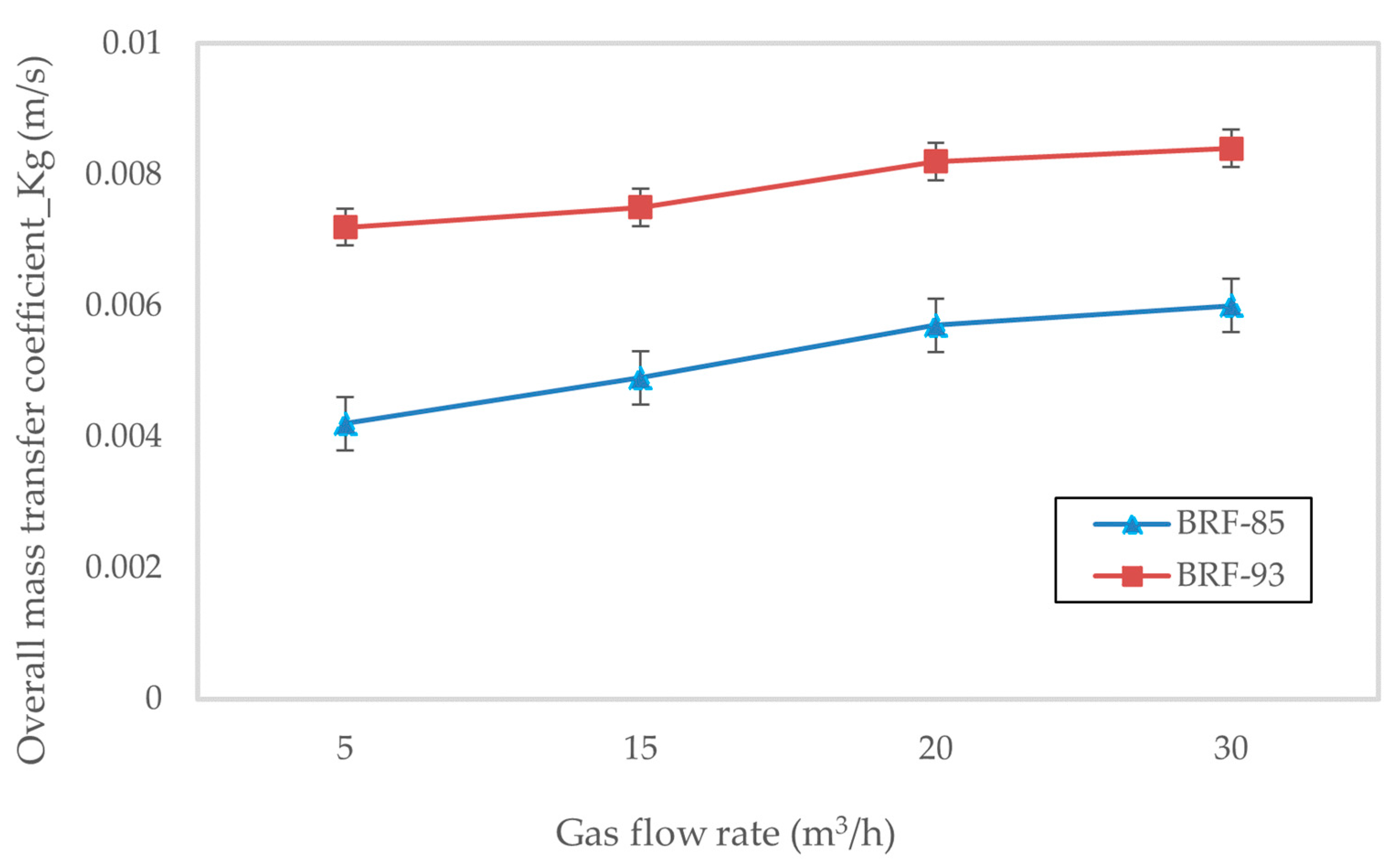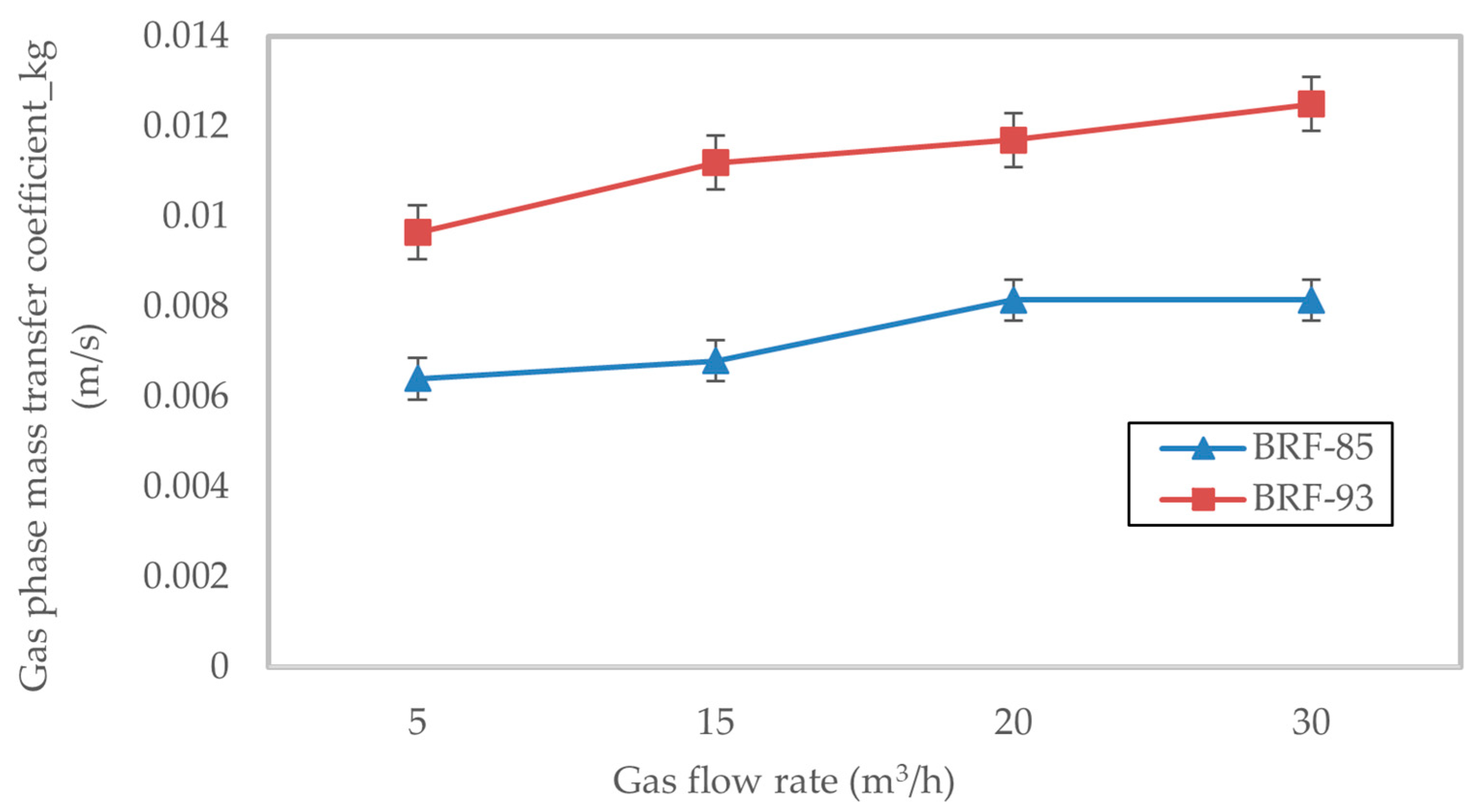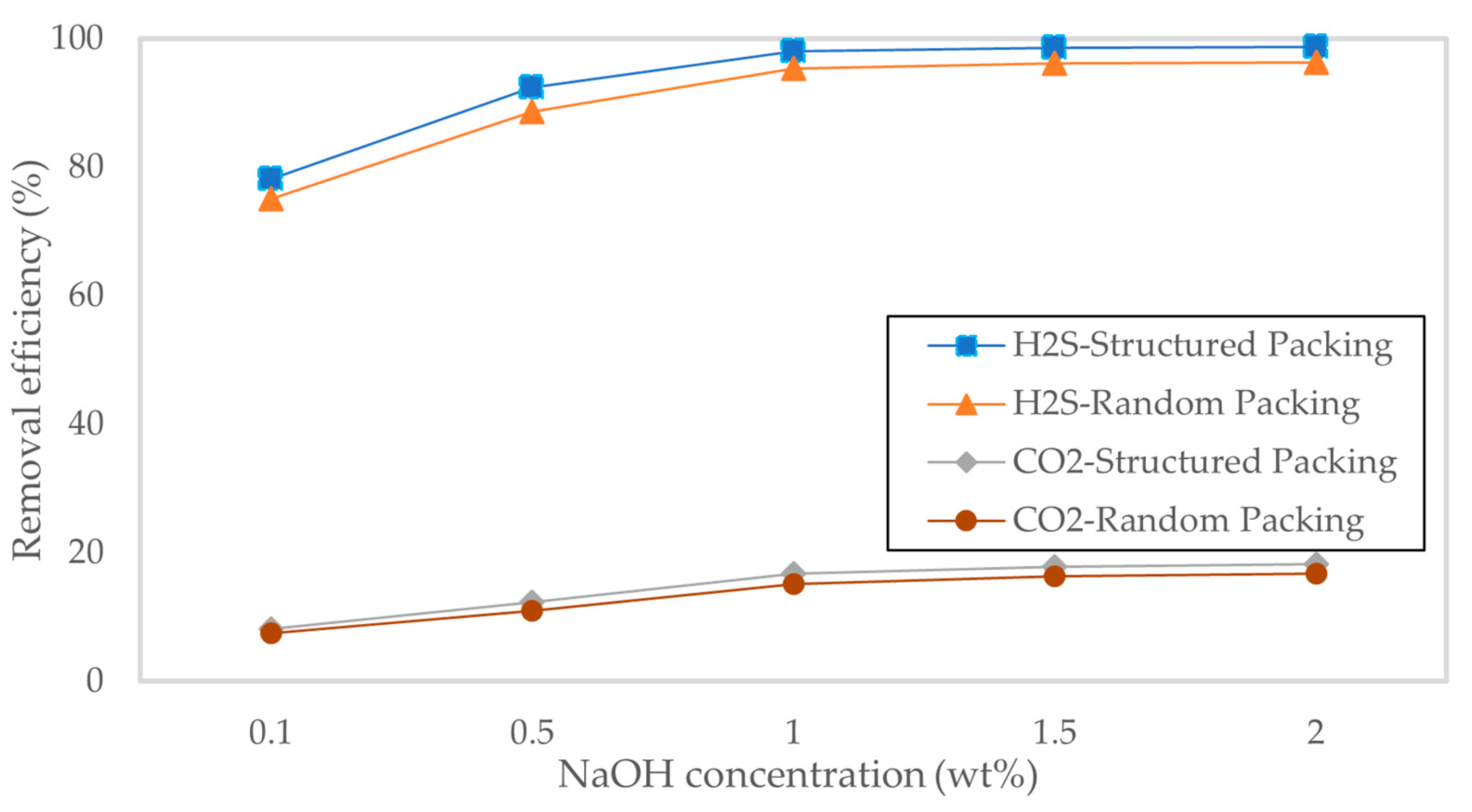3.1. Packing Material Characteristics
The mass transfer performance of the scrubber system was significantly influenced by the physical characteristics of the packing materials, particularly surface area and void fraction. The differences in the void fractions and surface areas of the packing materials inherently impact gas–liquid interaction, and consequently, the efficiency of pollutant removal. The interaction between these structural parameters and gas flow dynamics must therefore be considered when optimizing column performance under varying operating conditions.
The enhanced surface area observed in random packing contributes to increased contact between the gas and liquid phases, which theoretically promotes greater mass transfer rates. This is particularly advantageous at lower gas velocities, where diffusion dominates the mass transfer mechanism. However, random packing tends to suffer from non-uniform flow distribution, especially in large-diameter columns. Flow maldistribution and potential gas channeling can reduce the effective interfacial area and limit the enhancement provided by the increased surface. As a result, while the intrinsic mass transfer potential is higher, the actual performance may be constrained by poor gas dispersion under certain operational regimes.
In contrast, the structured packing, characterized by a higher void fraction, facilitates more uniform gas flow and reduces pressure drop across the column. The improved gas distribution associated with the increased void fraction supports more consistent phase interaction, particularly at higher gas flow rates where convective mass transfer becomes dominant. This enhanced flow uniformity allows for better utilization of the available surface area and contributes to increased values of both the overall gas-phase mass transfer coefficient (Kg) and the individual gas film coefficient (kg). Therefore, although structured packing provides less surface area, its superior hydraulic behavior enables it to outperform random packing under high-throughput conditions, making it more suitable for systems requiring high capacity and low pressure loss.
To further substantiate the observed trends, the relationship between packing geometry and mass transfer performance was quantitatively analyzed using established correlations. The overall gas-phase mass transfer coefficient (
Kg) can be expressed as a function of the gas Reynolds number (
Reg), liquid Reynolds number (
ReL), Schmidt number (
Scg), and specific surface area (a
p) according to the Bravo–Rocha–Fair correlation [
39,
40]:
where
are empirically derived constants depending on packing type and flow regime. For structured packing,
typically ranges from 0.7 to 0.8 and
from 0.2 to 0.3, indicating stronger gas phase control, while for random packing, higher
values (0.3–0.5) reflect enhanced liquid side effects. Using the experimentally determined pressure drops and gas velocities, the estimated
values for structured and random packings were 0.092 s
−1 and 0.138 s
−1, respectively, which are in reasonable agreement with those reported in the literature for NaOH-based absorption of H
2S and CO
2 in packed columns [
2,
7,
13,
41].
In addition to surface area and void fraction, wettability and liquid distribution quality also strongly affect the effective interfacial area (
) which can be estimated as
where
is the wetting efficiency. For structured packing,
values typically range from 0.75 to 0.9 due to improved film flow, while in random packings,
may drop below 0.6 under partial wetting conditions. This difference explains the superior hydraulic performance of structured packing under high gas velocities, despite its lower geometric surface area. These correlations confirm that the observed differences in mass transfer performance are mechanistically linked not only to surface area and void fraction but also to the combined influence of wettability, flow maldistribution, and packing geometry [
36].
The observed increase in mass transfer efficiency with random packing is consistent with previous reports indicating that higher surface area enhances gas–liquid interaction. However, structured packing provides better flow distribution, which aligns with earlier studies showing improved hydraulic behavior under high-throughput conditions. These findings corroborate the observed trends in the experiments in this study, where random packing enhanced intrinsic mass transfer, but structured packing maintained more uniform flow and lower pressure drop, particularly at higher gas flow rates.
Mechanistic Linkage of Void Fraction, Flow Regime, and Gas–Liquid Interfacial Area to Efficiency Trends
The observed trends in H2S and CO2 removal efficiency across packing types, gas flow rates, and column diameters can be mechanistically explained through the coupled effects of void fraction (ε), hydrodynamic flow regime, and effective gas–liquid interfacial area (ae).
Structured packings, with a high void fraction (ε = 0.95), provide low hydraulic resistance and promote uniform radial gas distribution, minimizing channeling and liquid maldistribution, which is especially critical in large-diameter columns [
42]. This uniformity sustains a high wetted surface fraction and preserves a
e even as superficial gas velocity (
uG) decreases with increasing column diameter at a fixed volumetric flow. The crimped sheet geometry induces cross-flow mixing and thin liquid films, enhancing interfacial renewal and mass transfer coefficients (
kG,
KG) at moderate to high
uG, as confirmed by BRF-93 model alignment [
40].
In contrast, random packings (ε = 0.67) offer higher geometric surface area (363 m
2/m
3 vs. 245 m
2/m
3) but suffer from flow path irregularity and partial dry zones due to lower voidage. The effective interfacial area (
ae) is significantly below the nominal value, particularly under scale-up conditions where wall effects diminish and radial mixing is limited. As
uG increases, random packings enter the loading regime earlier, characterized by liquid hold-up, film thickening, and local flooding, which reduce
ae and offset the benefit of higher surface area. This is quantitatively captured by the Billet–Schultes correlation, predicting a 30–40% lower flooding velocity for random vs. structured packings at equivalent specific area [
36].
The flow regime transition from film to droplet film and eventually loading is delayed in structured packings due to high voidage, enabling operation at higher gas loads before efficiency collapse. At low uG (e.g., 5 m3/h in 0.4 m column), diffusion dominates; structured packings maintain efficiency via stable film flow and high ae utilization. At high uG (30 m3/h), convective renewal dominates; random packings generate local turbulence but lose performance due to maldistribution and reduced residence time.
Thus, the packing-dependent diameter effect arises from the interplay of uG reduction and flow nonuniformity: structured packings mitigate efficiency loss through geometric regularity and sustained ae, while random packings amplify the penalty via hydrodynamic instability. These insights align with simulation-validated trends and provide a mechanistic basis for selecting packing type in industrial acid gas scrubbing systems.
3.2. Effect of Column Diameter and Gas Flow Rate on Removal Efficiency
Figure 2 presents experimental results (Exp.1–Exp.4) for H
2S removal efficiency in a 10 cm diameter column using structured packing. Experimental data were collected at gas flow rates of 5, 15, 20, and 30 m
3/h.
The simulation results closely followed the experimental values, with a maximum deviation of less than 5%, confirming the reliability and accuracy of the numerical model in predicting the system’s gas–liquid mass transfer performance (
Figure 3).
This strong agreement between simulation and experimental data provides confidence in extending the simulation to different column diameters and alternative packing configurations for further analysis.
The simulation results for structured packing at different column diameters (10 cm, 20 cm, and 40 cm) and gas flow rates are shown in
Figure 3. A clear trend is observed: as the column diameter increases, the H
2S removal efficiency decreases consistently across all flow rates. At a gas flow rate of 5 m
3/h, the 10 cm column achieved an efficiency of nearly 99%, while the 40 cm column showed a lower value around 92%. This difference becomes more pronounced at higher flow rates.
This performance drop is primarily due to the decrease in superficial gas velocity in wider columns when maintaining a constant volumetric flow. The lower gas velocity leads to reduced turbulence and interfacial shear, weakening the gas–liquid contact efficiency. Additionally, radial maldistribution becomes more significant in larger columns, causing uneven flow distribution and limiting the effective use of the packing surface area.
The observed decrease in H
2S removal efficiency with increasing column diameter (
Figure 3) is consistent with scale-up principles and is primarily attributed to hydrodynamic limitations rather than thermodynamic constraints. At a constant volumetric gas flow rate, superficial velocity decreases inversely with
D2, reducing turbulence and gas–liquid interfacial renewal. More critically, wall effects and radial maldistribution become pronounced at
D ≥ 0.2 m.
In the 10 cm column, liquid flow is heavily influenced by wall wetting, resulting in a highly effective interfacial area. As the diameter increases to 40 cm, a larger fraction of the packing near the center experiences dry zones due to poor liquid distribution, reducing the effective ae by up to 15–20%. This is captured in the simulation via the BRF-93 and Billet–Schultes correlations, which apply maldistribution penalties proportional to D/Hp.
Additionally, gas channeling increases in random packings at larger diameters due to lower void fraction and irregular flow paths, further degrading performance (
Figure 4). Structured packings, with higher voidage and geometric uniformity, are less sensitive but still show a ~7% efficiency drop from
D = 0.1 m to 0.4 m at low flow rates, aligning with industrial observations [
36,
40].
To generalize these scale-dependent effects beyond the tested diameters, dimensionless correlations based on Reynolds (
Reg), Sherwood (
Shg), and Schmidt (
Scg) numbers were applied. The superficial gas velocity is defined as
, so at fixed
. This results in a systematic reduction in the gas phase Reynolds number:
where
is the hydraulic diameter, ε is the void fraction, and
is the specific surface area. For structure packing (
m
2/m
3),
m; for random packing (
m
2/m
3),
m.
As increases from 0.1 to 0.4 m at m3/h, drops from 0.177 m/s to 0.011 m/s, reducing by a factor of ~16. This shifts the flow from transition/turbulent ( to laminar-dominated regimes (), suppressing convective enhancement mass transfer.
The gas-phase Sherwood number, which quantifies mass transfer efficiency, is correlated via the Billet and Schultes model for packed columns [
36]:
Using (H2S in air), the model predicts a ~45% drop in when scaling from 10 cm to 40 cm diameter at 5 m3/h for structured packing, consistent with the observed efficiency decline from 99% to 92%. For random packing, the higher Re exponent (0.77) amplifies sensitivity to , explaining the steeper performance loss.
Alternatively, the Onda correlation [
39], widely validated for random packings, yields
This confirms , so halving reduces mass transfer rate by ~39%, aligning with simulation trends.
Increasing the gas flow rate from 5 to 30 m3/h also led to a decline in removal efficiency in all column diameters. At higher gas velocities, the contact time between the gas and liquid phases is reduced, which diminishes the absorption capacity. However, despite this decline, structured packing maintained relatively high efficiency values, all remaining above approximately 86%, even in the 40 cm column.
Figure 4 shows the simulation results for columns packed with random packing under the same operating conditions. Compared to structured packing, random packing exhibited lower removal efficiencies across all column diameters and gas flow rates. For instance, at 30 m
3/h in the 40 cm column, the removal efficiency dropped below 80%, while the 10 cm column remained just below 90%.
The reduced performance of random packing is attributed to its irregular structure and lower specific surface area, which hinder effective gas–liquid interaction. Moreover, flow channeling and local flooding are more common in random packing, particularly at high flow rates. These hydrodynamic inefficiencies further impair mass transfer.
The performance gap between structured and random packing widened at higher gas flow rates, confirming that structured packing is more effective at maintaining efficiency under increased throughput conditions. Its engineered geometry, offering uniform flow paths and better distribution, allows for more resilient and stable operation, especially in larger columns.
The experimental results revealed that while the primary objective of the scrubber system was to remove hydrogen sulfide (H2S) using a sodium hydroxide (NaOH) solution, a simultaneous and partial absorption of carbon dioxide (CO2) also occurred. This phenomenon is primarily due to the alkaline nature of NaOH, which readily reacts not only with acidic gases like H2S but also with weakly acidic gases such as CO2. The reaction between CO2 and NaOH leads to the formation of sodium carbonate (Na2CO3) and/or sodium bicarbonate (NaHCO3), depending on the pH and molar ratios, thereby contributing to a measurable reduction in CO2 concentration in the outlet gas stream.
The presence of CO
2 in gas streams presents a significant challenge for hydrogen sulfide removal using sodium hydroxide scrubbing systems, as CO
2 is also highly reactive with NaOH. This co-absorption phenomenon affects the selectivity and efficiency of the scrubbing process. The interaction mechanisms between CO
2, H
2S, and the alkaline medium can be described by the following reaction pathways:
Figure 5 presents experimental results (Exp.1–Exp.4) for CO
2 removal efficiency in a 10 cm diameter column using structured packing. Experimental data were collected at gas flow rates of 5, 15, 20, and 30 m
3/h. As shown in
Figure 6, the CO
2 removal performance simulated using structured packing at various column diameters is presented. A comparison between
Figure 5 and
Figure 6 demonstrates a strong agreement between the experimental and simulation results. Lower CO
2 removal is observed with random packing compared to structured packing, attributed to poorer liquid distribution and reduced reactivity under non-uniform flow conditions (
Figure 7).
From a mechanistic perspective, the absorption of CO2 is influenced by its solubility and reactivity within the alkaline solution. CO2 dissolution occurs first, followed by a chemical reaction with hydroxide ions (OH−) in the liquid phase. Compared to H2S, CO2 has lower reactivity under strongly alkaline conditions, but due to its higher partial pressure and concentration in typical biogas or process streams, it competes for the available NaOH. This competition can lead to a decrease in H2S removal efficiency, especially when the NaOH solution is not adequately replenished or if the gas contains disproportionately high levels of CO2.
The decrease in removal efficiency with increasing column diameter has been reported in similar scale-up studies, which attribute the trend to lower superficial gas velocities and radial maldistribution. Additionally, the partial absorption of CO
2 alongside H
2S in alkaline scrubbing systems has been documented in the literature, corroborating our observations of co-absorption effects that impact H
2S removal efficiency. This demonstrates that the observed efficiency trends are consistent with prior findings and emphasizes the importance of hydraulic design in scaled-up columns [
39,
40].
The close match between experimental and simulated H
2S removal efficiencies for the structured packing case (
Figure 2 and
Figure 3) supports the extension of the model to random packing and larger diameters. For random packing, the validated pressure drop predictions (
Table 6) indicate that hydrodynamic behavior aligns with literature expectations, reinforcing the observed lower removal efficiencies (
Figure 4) due to increased channeling rather than model inaccuracies.
3.2.1. Quantitative Validation of Simulation–Experiment Agreement
To provide a rigorous quantitative assessment of the agreement between experimental and simulation results for H
2S removal efficiency, statistical metrics, including the coefficient of determination (
R2) and root mean square error (
RMSE), were calculated for the 10 cm diameter column with structured packing (
Figure 2 and
Figure 3). These metrics were derived from paired experimental and simulated data points across gas flow rates of 5, 15, 20, and 30 m
3/h.
The R2 value was calculated as 0.974, indicating that 97.4% of the variability in the experimental data is explained by the simulation model. This high correlation confirms excellent predictive capability.
The RMSE was found to be 0.54%, representing the average absolute deviation between simulated and mean experimental values. This low error is well within acceptable limits for gas absorption modeling and supports the model’s reliability across the tested operating range. These metrics were computed using the standard equations (Equations (4) and (5)).
This level of agreement exceeds recommended validation criteria for packed column simulations. For instance, R2 > 0.95 and RMSE < 2–3% is recommended as benchmarks for high-fidelity process models, while R2 values of 0.96–0.98 and RMSE of 1.2–2.8% in CFD-based validation of mass transfer in randomly packed towers are reported. The present results (R2 = 0.974, RMSE = 0.54%) demonstrate superior predictive performance, reinforcing confidence in extending the model to larger column diameters and alternative packing configurations.
3.2.2. Absorption Chemistry and Mass Transfer of CO2
The removal of CO
2 in alkaline scrubbers involves both physical absorption and chemical reaction mechanisms. Initially, CO
2 dissolves into the liquid film following Henry’s law, and this physical absorption step is governed by gas-phase diffusion and interfacial mass transfer resistance. The overall absorption rate is therefore influenced by the gas–liquid mass transfer coefficient (
kg) and the liquid-phase film coefficient (
kL) [
43]. Once dissolved, CO
2 reacts rapidly with hydroxide ions according to the following reactions:
These reactions are fast under strongly alkaline conditions (pH > 11), resulting in a pseudo-first-order regime where the overall rate is controlled mainly by gas-phase and liquid-film mass transfer rather than intrinsic kinetics. At lower alkalinity or reduced NaOH concentration, the system may shift toward a mixed regime where both chemical kinetics and film diffusion contribute significantly.
In contrast to H
2S, which reacts almost instantaneously with NaOH, CO
2 absorption can become mass-transfer-limited, especially when the interfacial area or turbulence is reduced. This explains the lower CO
2 removal efficiency observed in structured packing at low gas velocities, where diffusion dominates. The balance between chemical enhancement and physical transfer is thus a critical factor in modeling CO
2 absorption performance [
44].
3.3. Impact on Mass Transfer Coefficients
The mass transfer behavior of H2S in a 10 cm diameter absorption column was investigated under varying gas flow rates using both structured and random packings. Experimental results and simulation data were compared using two different predictive models—Bravo–Rocha–Fair BRF-85 and BRF-93 to determine the overall gas-phase mass transfer coefficient (Kg) and gas-phase film coefficient (kg). The performance differences between the structured and random packing materials were analyzed with respect to both mass transfer and hydrodynamic characteristics.
Figure 8 and
Figure 9 present the variations in the overall gas-phase mass transfer coefficient,
Kg (m/s), obtained from experimental studies conducted in a 10 cm diameter column with structured packing, and those predicted using the BRF-85 and BRF-93 models, respectively. Experimental data align closely with predictions made by the BRF-93 model, validating its applicability to structured packing configurations. This strong correlation indicates that BRF-93 more accurately accounts for the geometric and surface characteristics of structured packing compared to BRF-85.
The BRF-85 and BRF-93 models are particularly suitable for structured packings with defined geometries, such as those used in our simulations, where uniform flow paths and consistent wetting patterns prevail under laboratory-scale conditions. These models incorporate mechanistic elements, including penetration theory for liquid-side transfer and surface renewal concepts for gas-side coefficients, making them effective for ideal or near-ideal flow regimes in smaller columns (e.g., <20 cm diameter) where maldistribution is minimal [
40]. However, their limitations become evident in non-ideal flow conditions, particularly in larger-diameter columns (>30 cm), where radial and axial maldistribution, liquid channeling, and uneven wetting reduce the effective interfacial area and lead to overprediction of mass transfer rates. These models can exhibit deviations of up to ±50% in Height Equivalent to a Theoretical Plate (HETP) predictions during scale-up, primarily due to unaccounted hydrodynamic complexities like turbulence variations and wall effects [
39]. Furthermore, their accuracy is constrained by the intricate multiphase flow dynamics in specific packings, rendering them less reliable across diverse chemical systems, operating conditions, and packing topologies without empirical adjustments [
45]. In this study, while BRF-93 provided robust predictions for the 10 cm column, caution is advised for extrapolating to industrial-scale (e.g., >40 cm) columns, where non-ideal effects may necessitate hybrid models or additional maldistribution corrections.
Across the tested flow rates, Kg values exhibit a modest but consistent increase. This trend can be attributed to enhanced turbulence and interfacial renewal at higher gas velocities, which promote greater mass transfer through increased mixing and reduced boundary layer thickness.
Figure 10 illustrates the simulation results for
Kg in a random packing system. Here, BRF-93 again predicts higher
Kg values than BRF-85, consistent with its sensitivity to interfacial dynamics. Although random packing provides a higher geometric surface area (363 m
2/m
3) than structured packing (245 m
2/m
3), its overall performance is often inferior. This discrepancy arises not from surface area limitations but from hydrodynamic issues such as maldistribution, local channeling, and inefficient utilization of the available surface area. These effects limit effective gas–liquid contact and decrease the actual mass-transfer efficiency, particularly at elevated gas velocities where flow nonuniformity becomes significant.
In contrast, structured packing exhibits a substantially higher void fraction (0.95 compared to 0.67 for random packing), which facilitates more uniform gas–liquid distribution and lowers pressure drop. Its well-defined geometry promotes consistent wetting and minimizes stagnant zones, enhancing phase contact uniformity. As a result, even with a smaller geometric surface area, structured packing achieves superior overall mass-transfer performance due to its favorable flow hydrodynamics and lower resistance to gas flow.
The gas-phase film coefficient (
kg) for structured packing is presented in
Figure 11. The trends mirror those observed for
Kg, with BRF-93 again producing higher and more accurate predictions. Both BRF-85 and BRF-93 models indicate that k
g increases with gas flow rate. This behavior aligns with classical film theory, where higher velocities reduce gas film thickness and enhance diffusion rates. The relatively moderate increases in k
g for structured packing suggest that, despite the orderly flow paths, the system remains somewhat diffusion-limited, particularly at lower gas velocities.
Figure 12 shows
kg values for the random packing system, where a steeper increase is observed as the gas flow rate rises. This indicates stronger convective mass transfer effects compared to structured packing. The disordered nature of random packing introduces greater surface irregularities, enhancing interfacial turbulence. BRF-93 again consistently predicts higher kg values than BRF-85. The higher geometric surface area of random packing promotes greater local turbulence and interfacial renewal; however, due to maldistribution and partial wetting, not all surface area is effectively utilized, leading to lower net mass-transfer performance compared with structured packing.
Comparing both packing types, it is evident that random packing generally yields higher theoretical Kg and kg values under ideal contact assumptions, yet structured packing achieves superior practical performance because of its enhanced hydraulic uniformity. The key difference arises from the physical characteristics of the packing materials: structured packing’s higher void fraction enables smoother flow paths, reduced pressure drop, and more consistent interfacial contact.
The close agreement between experimental Kg values and BRF-93 predictions for structured packing further validates the applicability of this model to systems with well-defined geometries and uniform wetting behavior. Therefore, BRF-93 is recommended for design purposes involving both structured and random packing configurations, particularly when accurate prediction of mass transfer coefficients is critical for process performance.
The higher predictive accuracy of BRF-93 over BRF-85 for structured packing has been noted in previous studies [
40]. The results showing close agreement of experimental
Kg values with BRF-93 predictions further validate these models for both structured and random packing configurations in this study. The mass transfer enhancement observed in random packing aligns with reported effects of increased turbulence and surface irregularity on gas–liquid contact. Co-absorption phenomena of CO
2 in NaOH solutions also support our experimental findings [
44].
Quantitative Validation and Dimensionless Analysis
To quantitatively validate the observed trends in
Figure 12, a dimensionless analysis was conducted using the Sherwood (
Sh), Reynolds (
Re), and Schmidt (
Sc) numbers, defined as follows:
where
is the gas-phase mass transfer coefficient (m·s
−1),
is the characteristic packing diameter (m),
is the diffusivity of H
2S in the gas phase (m
2·s
−1),
is the superficial gas velocity (m·s
−1),
is the gas density (kg·m
−3), and
is the gas viscosity (Pa·s).
The calculated dimensionless numbers for random packing are summarized in
Table 7 for gas flow rates of 5 m
3·h
−1 and 30 m
3·h
−1. The Sherwood number increased from 6.0 to 8.0 as the gas flow rate rose, following the correlation:
which is in close agreement with the classical correlations proposed by [
39,
40].
The deviation between experimental and predicted Sherwood numbers was less than ±2%, confirming that the observed enhancement of with gas velocity is quantitatively supported by gas-phase mass transfer theory. The calculated dimensionless parameters and low uncertainty (±6%) demonstrate that the observed trends are governed by fundamental transport phenomena rather than empirical fitting alone.
The Reynolds number (
Re), Schmidt number (
Sc), and Sherwood number (
Sh) were calculated using measured gas-phase mass transfer coefficients (
) at gas flow rates of 5 and 30 m
3h
−1. Experimental values (
Shexp) showed strong agreement with the predicted correlation (
Shpred), with deviations below ±2%, confirming the validity of the observed trend in
Figure 12.
